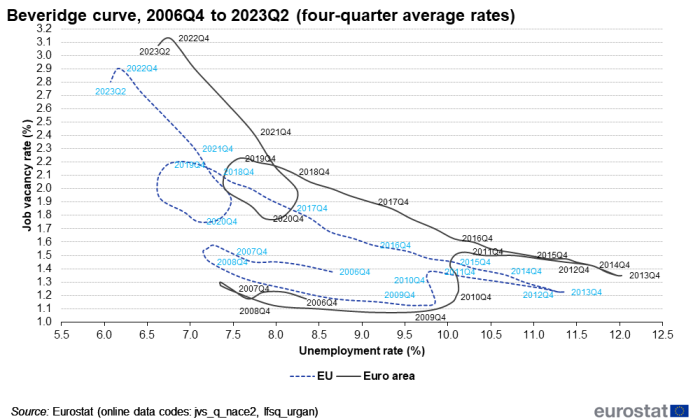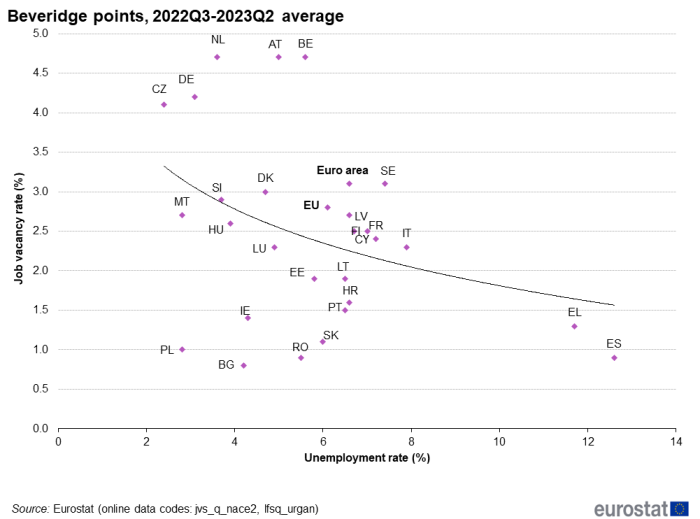Job vacancy and unemployment rates - Beveridge curve
Data extracted in December 2023
Planned article update: 14 June 2024
Highlights

Source: Eurostat (jvs_q_nace2) and (lfsq_urgan)
This article gives an overview of developments in the relationship between the job vacancy rate (JVR) and the unemployment rate (UR) in the European Union (EU). The most recent developments in job vacancy statistics are analysed here and in the unemployment rate here.
Full article
Background
The Beveridge curve reflects the negative relationship between vacancies and unemployment. Fluctuations in aggregate demand generate movements along the curve. During contractions of the economy, there are few vacancies and high unemployment, while during expansions there are more vacancies and the unemployment rate is low.
Structural changes in the economy can also generate outward or inward shifts in the Beveridge curve. In the first case, concurrent increases in the vacancy and unemployment rates can be identified at times of uneven growth across regions or industries when the matching efficiency between labour supply and demand decreases. In the case of inward shifts, concurrent decreases in the vacancy and unemployment rates can be observed when the matching efficiency of the labour market improves. This could be, for example, due to a better flow of information on job vacancies thanks to the internet.
The empirical analysis of the curve can be challenging, as both movements along the curve and shifts might take place at the same time with different intensities.
Figures averaged over four quarters
To show a clearer picture, we averaged JVR figures over four quarters (e.g. the figure for the second quarter of 2022 is calculated as an average of 2021Q3, 2021Q4, 2022Q1 and 2022Q2 and so forth for the other quarters). Consistently, we also averaged URs based on quarterly LFS data over four quarters. As a consequence, figures used in this publication differ from those mentioned in other Eurostat releases.
The Beveridge curves for the euro area and the EU
Figure 1 displays the Beveridge curves of the euro area and of the EU. We observe that the Beveridge curve of the euro area is outward shifted compared with the EU curve. This indicates that job-seekers and vacant posts match better in non-euro area countries (see also Figure 2). The 2008-2009 worldwide recession and the ensuing sovereign debt crisis had a major impact on the EU labour markets with the unemployment rate soaring and job vacancies plummeting at the same time. From 2010 to 2013 and most notably over the 2010-2011 period, there was a significant outward shift in the Beveridge curves that may reflect disparities across EU Member States: most of the job vacancies were created in countries with comparatively low unemployment. From 2014 onwards, we can observe movements along the Beveridge curve caused by an increase of the job vacancy rates in the euro area and the EU going along with a decrease in the unemployment rates in both areas. As of the first quarter of 2020, the COVID-19 crisis translated into a marked decrease in job vacancy rates with a reduced impact on unemployment rates, probably because the sectors most hit by the crisis (e.g. NACE rev. 2 section I: 'Accommodation and food service activities') were also those with the highest difficulties to recruit. This trend continued until 2020Q4 when the job vacancy rates started increasing again. This rise continued until 2021Q2 which closed the loop caused by the COVID-19 crisis, with both the job vacancy and the unemployment rates reaching their pre-pandemic levels. This would indicate that labour markets recovered quickly from the COVID-19 crisis with no impact on the overall matching between labour supply and demand. From 2021Q3 until 2022Q4, we observe a further increase in job vacancy rates but with poorer matching (outward shift of the curve) with a reverse shift in 2023Q1 and 2023Q2 (unemployment rates still decrease while the job vacancy rates start diminishing).

Source: Eurostat (jvs_q_nace2) and (lfsq_urgan)
Cross-country Beveridge 'points'
As a further step in the analysis, one can plot the JVR and the UR of a given country at a given moment in time. This provides insights on job matching in national labour markets. As can be seen in Figure 2, the countries cluster in different groups. At the upper end of the regression curve are Czechia, Germany and the Netherlands with rather low unemployment and high vacancy rates, while at the lower end of the curve are Greece and Spain with high unemployment and low vacancy rates. The countries above the curve may have a comparatively poorer matching efficiency than countries situated below. It must be noted that job vacancy statistics do not cover the whole economy in Denmark, France and Italy which may impact the JVR/UR relationship.

Country codes
Source: Eurostat (jvs_q_nace2) and (lfsq_urgan)
Source data for tables and graphs
Data sources
The basis for this analysis are quarterly data on unemployment, vacancies and occupied posts. Quarterly data on job vacancies and occupied posts may be presented as broken down by economic activity and enterprise size. The national statistical authorities responsible for compiling job vacancy statistics send these statistics to Eurostat. Their data are used to compile the job vacancy rate for the EU Member States, the EU and the euro area.
Some of the data provided by the EU Member States fail to match common criteria and there may be differences in the coverage of the data between countries, as a result, there are currently no EU totals for the actual numbers of job vacancies or occupied posts. The EU and euro area job vacancy rates are calculated on the basis of the information that is available. It is therefore not possible, at present, to calculate EU or euro area job vacancy rates broken down by economic activity or size of enterprise.
Context
The job vacancy rate, in part, reflects the unmet demand for labour, as well as potential mismatches between the skills and availability of those who are unemployed and those sought by employers. Job vacancy statistics are used by the European Commission and the European Central Bank (ECB) to analyse and monitor the evolution of the labour market at national and European level. These statistics are also a key indicator used for an assessment of the business cycle and for a structural analysis of the economy.
Policy developments in this area have mainly focused on trying to improve the labour market by more closely matching supply and demand, through:
- modernising and strengthening labour market institutions, notably employment services;
- removing obstacles to worker mobility across Europe;
- better anticipating skill needs, labour market shortages and bottlenecks;
- managing economic migration;
- improving the adaptability of workers and enterprises so that there is a greater capacity to anticipate, trigger and absorb economic and social change.
EU policies in the area of job vacancies aim to improve the functioning of the labour market by trying to more closely match supply and demand. In order to enable job seekers to consult all vacancies publicised in each of the EU Member State's employment services, the European job mobility portal EURES was set up.
Direct access to
- Job vacancies, see:
- Job vacancies in number and % - NACE Rev. 2, B-S, quarterly data (tps00172)
- Job vacancies, see:
- Job vacancy statistics by NACE Rev. 2 activity - quarterly data (from 2001 onwards) (jvs_q_nace2)
- Job vacancy statistics by NACE Rev. 2 activity, occupation and NUTS 2 regions - quarterly data (jvs_q_isco_r2)
- Job vacancy rate by NACE Rev. 2 activity - annual data (from 2001 onwards) (jvs_a_rate_r2)
- Job vacancy statistics - historical data (jvs_h)
- Job vacancy statistics by occupation and NUTS 2 regions and NACE Rev 1.1 activity - annual data (2000-2008) (jvs_a_nace1)
- Job vacancy statistics by NACE Rev. 1.1 activity - quarterly data, (2001Q1-2009Q4) (jvs_q_nace1)
- Job vacancy statistics by occupation, NUTS 2 regions and NACE Rev. 2 activity - annual data (2008-2015) (jvs_a_nace2)